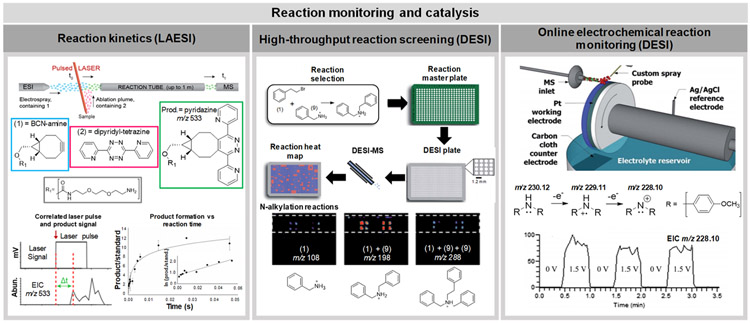Figure 8.
Highlights of the application of ambient ionization MS techniques in reaction monitoring and catalysis. The left panel shows the use of LAESI-MS to monitor the formation of click reaction products. The pulsed laser ablates the tetrazine (2) and interacts with the cyclooctyne (1) within the ESI plume, followed by reaction within a varied length reaction tube and sequential MS analysis. The time between the laser pulse that initiated reactant ablation and product detection in the mass spectrometer was monitored and utilized to determine the kinetics of reaction. Adapted from van Greenan, F. A. M. G.; Franssen, M. C. R.; Zuilhof, H.; Nielen, M. W. F. Anal. Chem. 2018, 90, 10409–10416 (ref 211) . Copyright 2018 American Chemical Society. The center panel illustrates the use of DESI-MS for high-throughput reaction screening. The reactants are spotted onto a DESI plate and analyzed, allowing quick identification of successful reactions to then be scaled-up. For example, the technique was used to study 16 alkylation reactions, with the reaction between benzylamine (1) and 2-(bromoethyl)benzene (9) shown. Reproduced from Wleklinski, M.; Loren, B. P.; Ferreira, C. R.; Jaman, Z.; Avramova, L.; Sobreira, T. J. P.; Thompson, D. H.; Cooks, R. G. Chem. Sci. 2018, 9, 1647–1653 (ref 212), with permission of The Royal Society of Chemistry. The right panel shows the use of DESI-MS to detect electrochemically generated nitrenium ions directly from a rotating platinum electrode, confirming that nitrenium is formed through oxidation of 4,4′-dimethoxydiphenylamine, but only when a voltage is applied to the working electrode. Adapted from Brown, T. A.; Hosseini-Nassab, N.; Chen, H.; Zare, R. N. Chem. Sci. 2016, 7, 329–332 (ref 218), with permission of The Royal Society of Chemistry.

